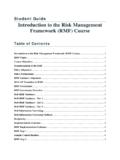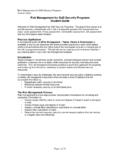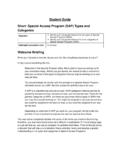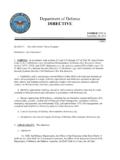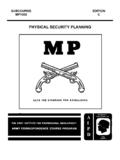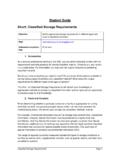Transcription of Student Guide Course: Physical Security Planning …
1 Student Guide course : Physical Security Planning and implementation Lesson 1: course introduction 1. course Information Purpose Provide a thorough understanding of Physical Security Planning and implementation within the DoD Audience Military, civilian, and contractor personnel responsible for Physical Security Pass/Fail % 75% on final examination Estimated completion time 145 minutes 2. course Overview Planning for the Physical Security of Department of Defense (DoD) installations and resources is imperative for our national Security . In this course , you will learn about various components of Physical Security Planning and implementation .
2 These components include Physical Security roles; the risk management model; facility design; Physical Security Planning documents; the DoD Antiterrorism Program, which includes Terrorist Threat Levels and Force Protection Conditions (FPCONs); and the oversight of the Physical Security program. 3. course Objectives Here are the course objectives: Identify the components of Physical Security Planning and implementation Identify the roles in Physical Security Identify the components of the risk management model Identify what Terrorist Threat Levels are and who establishes them Identify what Force Protection Conditions are and who establishes them Identify Physical Security protective measures that should be incorporated into new and existing facility design Identify Physical Security Planning documents and their purposes.
3 Including a facility s Physical Security plan Identify the purpose of oversight and the oversight tools Physical Security Planning and implementation course introduction Student Guide Page 2 4. course Structure This course is organized into the lessons listed here: course introduction What is Physical Security Planning and implementation ? Facility Design Physical Security Planning Documents DoD Antiterrorism Program Oversight course Conclusion Student Guide course : Physical Security Planning and implementation Lesson 2: What is Physical Security Planning and implementation ?
4 Lesson introduction 1. Objectives This lesson will familiarize you with a variety of concepts related to Physical Security Planning and implementation in the Department of Defense (DoD), including the risk management process and the various roles involved in the Planning and implementation of Physical Security . Lesson objectives: Identify the components of Physical Security Planning and implementation Identify the components of the risk management model Identify the roles in Physical Security 2. Overview Physical Security Planning is deciding which Security measures will be used to prevent unauthorized access to DoD assets and to safeguard those assets against threats such as espionage, sabotage, terrorism, damage, and criminal activity.
5 In Physical Security Planning , the risk management process is used to provide a systematic approach to acquiring and analyzing the information necessary for protecting assets and allocating Security resources against the threats. Physical Security implementation is the execution of Physical Security plans, including the oversight and inspection process, which ensures those plans are properly implemented. 3. Policy The DoD has implemented several DoD-wide policy documents that Guide DoD Physical Security Planning and implementation , such as: DoD , Physical Security Program DoD Instruction (DoDI) , Security of DoD Installations and Resources and the DoD Physical Security Review Board (PSRB) DoD Directive (DoDD) , DoD Defense Continuity Program DoDI , DoD Antiterrorism Program DoDI , DoD Antiterrorism Standards DoD Antiterrorism Officer Guide Physical Security Planning and implementation What is Physical Security Planning and implementation ?
6 Student Guide Page 2 DoDM DoD Information Security Program The Army, Navy, Marine Corps, and Air Force issue specific implementation guidance for their individual service branches. You should always consult your component s policy for specific guidance. Physical Security Planning 1. Risk Management Process In order to plan and implement effective Physical Security measures, you must use the risk management process to determine where and how to allocate your Security resources. The steps in the risk management process are: assess assets; assess threats; assess vulnerabilities; assess risks; determine countermeasure options; and make risk management decisions.
7 For in-depth training on the risk management process, refer to the Risk Management for DoD Security Programs eLearning course offered by DSS Center for Development of Security Excellence. a. Assess Assets Properly designed and executed Physical Security programs should deter or prevent, to the greatest degree possible, the loss of, theft of, or damage to an asset. DoD assets include people, information, equipment, facilities, activities, and operations. Combined, these assets are referred to as PIE-FAO. When assessing an asset, you must determine the nature and value of that asset and the degree of impact if the asset is damaged or lost.
8 B. Assess Threats Next you must identify and assess the threats to those assets. A threat can be an indication, circumstance, or event with the potential to cause loss of, or damage to, an asset or capability. Examples of threats include threats from the Foreign Intelligence Entities, criminal activities, insider threats, terrorist organizations, cyber threats, and business competitors. c. Assess Vulnerabilities Next you must identify the vulnerabilities, or situations or circumstances, which if left unchanged, may result in the degradation, loss of life, or damage to mission-essential resources, and determine their extent.
9 Vulnerabilities are weaknesses, characteristics, or circumstances that can be exploited by an adversary to gain access to or information from an asset. Vulnerabilities can be the result of a variety of factors, such as the way a building was constructed, location of people, equipment, operational practices, and even personal behavior. Physical Security Planning and implementation What is Physical Security Planning and implementation ? Student Guide Page 3 d. Assess Risks Once you have identified your assets, threats, and vulnerabilities, you must then assess your risks.
10 Think about the impact if your assets are being compromised, such as loss of strategic or military advantage or even loss of life. e. Determine Countermeasure Options Once you ve calculated the risks, you must determine which countermeasures you might employ to protect our DoD assets by reducing our vulnerabilities and mitigating our threats. Countermeasures include what Security measures you employ up front in facility design, in the day-to-day protection of DoD assets, and in times when threat levels increase. f. Make Risk Management Decisions Once you ve determined your countermeasure options, you must make risk management decisions based on the cost versus the benefit of protecting DoD assets.
